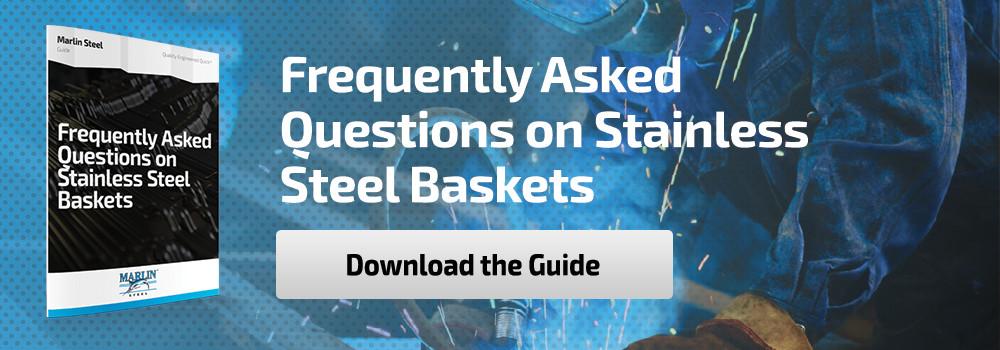 Many of the custom wire baskets that Marlin Steel makes are intended to hold either very small and delicate parts, or very large and tough parts. However, what happens when a part is both large and delicate—complete with a no-scratch surface requirement?
Many of the custom wire baskets that Marlin Steel makes are intended to hold either very small and delicate parts, or very large and tough parts. However, what happens when a part is both large and delicate—complete with a no-scratch surface requirement?
This was the challenge that one manufacturing client posed to Marlin when they asked for a custom wire parts washing basket that could hold one ton or more of weight with parts where metal-to-metal contact was a major concern. While tough, Marlin’s engineering team was up to the challenge of designing the ideal custom wire basket for the client’s parts washing needs.
Why the Client Needed New Custom Wire Baskets
The client already had heavy-duty wire washing baskets for their large-scale parts washing equipment. How big was the client’s washing system cavity? About 6’ diameter and 8’ high. The client needed this massive washing cavity to process their larger-scale parts, some of which were several feet long or wide.
However, the client’s existing baskets were “universal style” meaning there were no guides or racks to help hold parts in place—the baskets simply had one big, empty space. So, parts would lie on the bottom of the basket in a single layer, with the rest of the vertical space in the basket going to waste. This limited the number of parts that the client could process at once, and it would take them between two and four wash cycles to do all of the parts necessary to complete a “common” job.
Laying the parts flat on the bottom of the basket increased the risk of parts bumping together during the wash cycle. This, in turn, could cause extra damage to the held parts that would increase parts rejections.
Another problem was that the client’s existing baskets would cause damage to their factory’s floor when moved, digging gouges into the concrete when holding heavy parts. Part of the issue was that these baskets had sharp metal feet that would scrape the ground.
Creating a Better Parts Washing Wire Basket
Marlin’s degreed engineers immediately went to work on designing the optimal wire basket for the client’s washing processes.
To solve the problem of the basket damaging held parts, Marlin’s degreed engineers decided to add a coating, such as polyvinyl chloride (PVC), to the basket’s wires. This would provide a soft contact surface for the parts to rest against as well as increasing the coefficient of friction between the parts and the basket—preventing parts from sliding around in the basket.
To increase the storage capacity of the basket and improve the efficiency of the wash process, a series of dividers and racks were added to the custom wire basket. These special holders would keep some of the larger, disc-shaped parts held vertically so they would take up less space at the bottom of the basket. Additionally, some elevated racks would hold smaller parts in place, with rack-like assemblies built into the bottom of the basket for other small parts. This increased the space efficiency of the basket while simultaneously ensuring a consistent distribution of weight.
Marlin’s engineering team reached out to the client during the design process to propose several different versions of the wire basket’s internal layout to determine which one was the best fit for the client’s needs.
To prevent the basket from damaging the client’s floors and allow forklift tines to get under the basket with ease, a set of feet were added to the design. These feet would also be coated to help prevent accidental scraping and gouging of factory floors during movement.
Heavy-gauge stainless steel wires would be used for the frame of the basket, as the sheer weight of the parts it would hold would be massive. In fact, expanded metal was considered for this basket, but the washing process needed more open space than what expanded metal would provide.
Making Sure the Wire Baskets Would Hold Up
Before beginning assembly for the custom wire baskets, Marlin’s engineering team ran the design through a finite element analysis (FEA) software program. This FEA software would simulate the effects of the basket holding up to one metric ton of parts through a 180-degrees Fahrenheit washing process for hours on end each day for years of use.
If the wires would bend or break under the stress, the software would generate a report detailing the cause (or causes) of the failure so the engineering team could correct the flaw in the design. Using this type of software-based stress testing, Marlin’s degreed engineers could iterate several versions of the design in a single day—a process that would have taken months with physical prototype testing.
With FEA testing, Marlin’s degreed engineers were able to perfect the design without having to waste a single piece of stainless steel wire. In the end, Marlin was able to complete the client’s custom wire basket request in time for the end of the year—helping the client claim the processing baskets in time to deduct the expenses on their taxes and before the new year’s budget reset.
Need a custom wire basket ASAP? Reach out to the experts of delivering “Quality, Engineered Quick®” at Marlin Steel today!



.gif)


